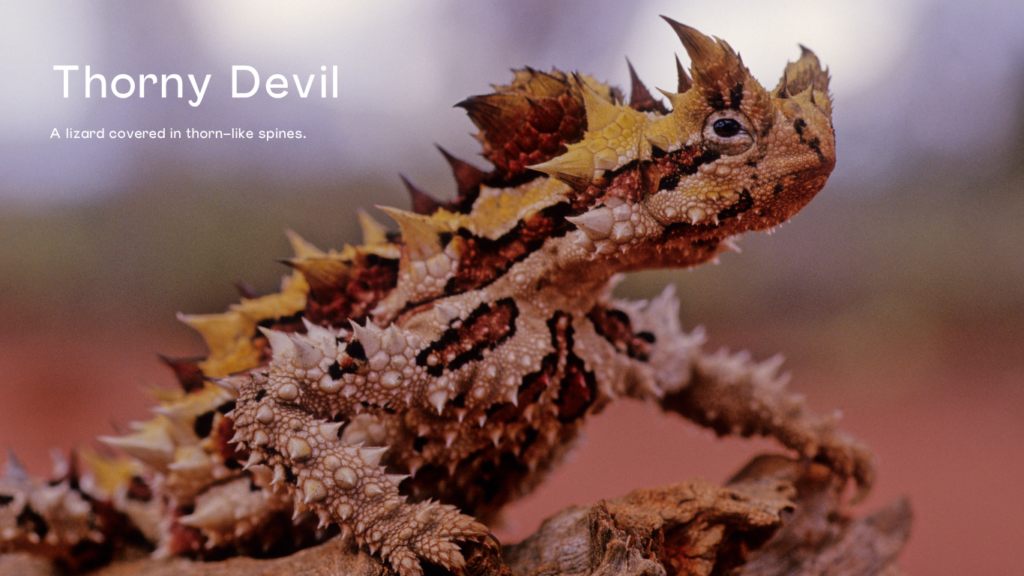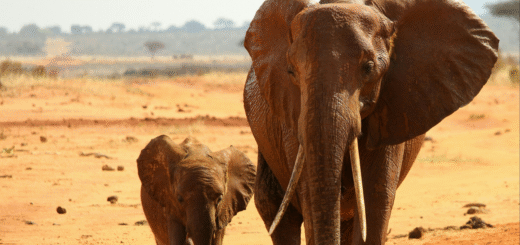The Thorny Devil: Nature’s Desert Survivor
The Thorny Devil, also known as Moloch horridus, is one of nature’s most unusual and intriguing reptiles. Native to Australia’s arid regions, this small lizard is renowned for its prickly appearance, unique adaptations, and remarkable survival strategies in the harsh desert environment. Known for its distinctive thorn-covered body and mesmerizing color-changing abilities, the Thorny Devil has captivated biologists and reptile enthusiasts alike. Let’s take a deeper look into what makes the Thorny Devil such a fascinating creature.

Physical Characteristics
The Thorny Devil is unmistakable in appearance. Growing up to 20 centimeters (around 8 inches) in length, this lizard is covered from head to tail in spiky protrusions, making it look like a miniature dinosaur. These sharp, conical spines serve multiple purposes. Firstly, they provide protection from predators; the Thorny Devil’s prickly armor deters most animals from attempting to swallow it whole. Secondly, the spines aid in collecting and channeling water toward the Thorny Devil’s mouth—an essential adaptation for an animal that lives in such arid habitats.
One of the Thorny Devil’s most intriguing features is a “false head” located on the back of its neck. When threatened, the Thorny Devil will lower its real head, revealing the “false head” hump, which helps to confuse predators, diverting their attention from its vulnerable parts. This clever adaptation demonstrates the remarkable evolution of survival tactics in desert wildlife.
Color and Camouflage
The Thorny Devil’s appearance is also designed to blend in with the desert environment. Its skin color changes throughout the day, depending on temperature, sunlight, and mood. In cooler parts of the day, the Thorny Devil’s skin tends to be darker shades of brown and reddish-brown, while it becomes lighter and even golden under direct sunlight. This color-changing capability is a form of camouflage, allowing the Thorny Devil to remain hidden from both predators and prey against the sandy, sunlit terrain.
Habitat and Distribution
The Thorny Devil is found primarily in the arid and semi-arid deserts of Western Australia, Northern Territory, and parts of South Australia and Queensland. These regions are characterized by extreme temperatures, sparse vegetation, and limited water resources. Thorny Devils are well-suited to these conditions and have developed several unique ways of surviving in such a harsh environment. Their low body temperature and reliance on external heat sources make them particularly well-adapted to the desert’s temperature fluctuations.
Thorny Devils are solitary animals, preferring to live independently rather than in groups. They establish a small home range, which they defend from intruders. Their slow, deliberate movements across the sand reflect their energy-conserving lifestyle, which is essential for survival in regions where resources are scarce.
Diet and Feeding Habits
The Thorny Devil’s diet consists almost exclusively of ants—particularly, the Australian Iridomyrmex species. With a specialized feeding mechanism, this lizard can consume thousands of ants in a single day. The Thorny Devil has a sticky, grooved tongue that allows it to capture ants efficiently, scooping them up one at a time. Its strong sense of smell helps it locate ant trails, and it can spend hours at a time eating without moving from its position.
Interestingly, Thorny Devils exhibit a “sit-and-wait” approach to hunting, remaining stationary on or near an ant trail and letting their prey come to them. Their unique dietary specialization is an evolutionary advantage, as it allows them to focus on a single food source that is consistently available, even in their harsh, nutrient-poor habitat.
Water Collection and Conservation
Water is a critical resource in the desert, and the Thorny Devil has developed remarkable methods to stay hydrated. Its skin has a complex system of microscopic grooves and channels between the scales, which can absorb and direct water across the body toward the mouth. When it rains or when there is dew, the Thorny Devil simply stands still, allowing water to flow down these grooves to drink. Even in the absence of direct water sources, the Thorny Devil can collect moisture from the environment through capillary action. For example, it can press its body against damp sand or vegetation to collect minute amounts of moisture.
This adaptation is especially useful during dry spells, which can last for months in some parts of the Thorny Devil’s range. Its ability to absorb and conserve water is vital to its survival and is one of the most unique features observed in desert reptiles.
Reproduction and Life Cycle
Thorny Devils reach sexual maturity at about three years of age. Breeding season occurs in the Australian spring, between September and December, when food sources become more abundant. Males engage in a brief courtship with females, which typically involves following her and performing a series of head bobs to show interest.
After mating, the female Thorny Devil will dig a small burrow to lay her eggs. The eggs are soft-shelled and are carefully deposited in a small chamber, which the female covers with soil to protect from predators and temperature fluctuations. Clutches typically contain between 3 to 10 eggs, which incubate for around three to four months before hatching.
Upon hatching, young Thorny Devils are immediately independent. They are miniature versions of adults, complete with spiny armor and a preference for ants as their main food source. The young face many challenges in the early stages of life, as they are particularly vulnerable to predators until they grow larger and their spines fully develop.
Conservation and Threats
Currently, Thorny Devils are not considered endangered, and their populations remain stable across their natural range. However, habitat destruction and climate change pose potential threats to their long-term survival. As their habitat is altered by human activities, particularly agricultural expansion and mining, Thorny Devils could experience shifts in food availability and temperature, which could disrupt their delicate balance with the environment.
Additionally, increased vehicle traffic on desert roads has led to higher mortality rates among Thorny Devils, which are often slow-moving and unable to evade oncoming cars. Conservationists are monitoring these threats, and environmental protection measures, such as wildlife crossings and habitat preservation, are vital to ensuring the Thorny Devil’s survival in the wild.
Cultural Significance and Human Interest
The Thorny Devil holds a special place in Australian culture and folklore. Its otherworldly appearance and unique behaviors have led to its recognition as an iconic desert species. Many Aboriginal cultures regard the Thorny Devil as a symbol of endurance, adaptability, and resilience—traits highly valued in societies that have lived in harmony with Australia’s rugged landscapes for millennia.
In recent years, the Thorny Devil has also attracted attention from the scientific community, which studies its unique water-collection adaptations and other survival strategies. Researchers hope that understanding these mechanisms could have applications in technology and agriculture, particularly in regions facing water scarcity.
Conclusion
The Thorny Devil is a marvel of desert adaptation and a testament to the diversity of life in extreme environments. With its spiny armor, camouflage abilities, specialized diet, and ingenious water-collecting skin, this resilient lizard exemplifies nature’s ingenuity. While they may appear intimidating with their thorny exteriors, Thorny Devils play an essential role in the delicate desert ecosystem and remind us of the incredible diversity found in some of Earth’s harshest climates.
Through continued conservation efforts and appreciation of this unique species, the Thorny Devil will hopefully remain an emblem of Australia’s wild beauty and an enduring example of life’s ability to adapt and thrive against the odds.








